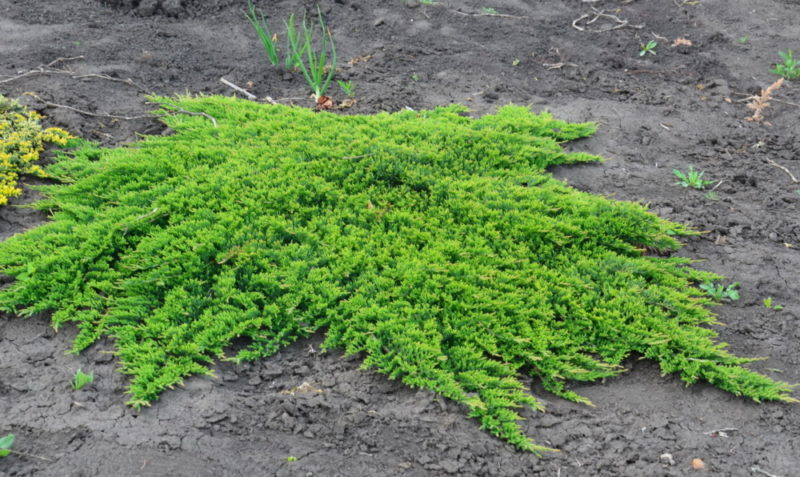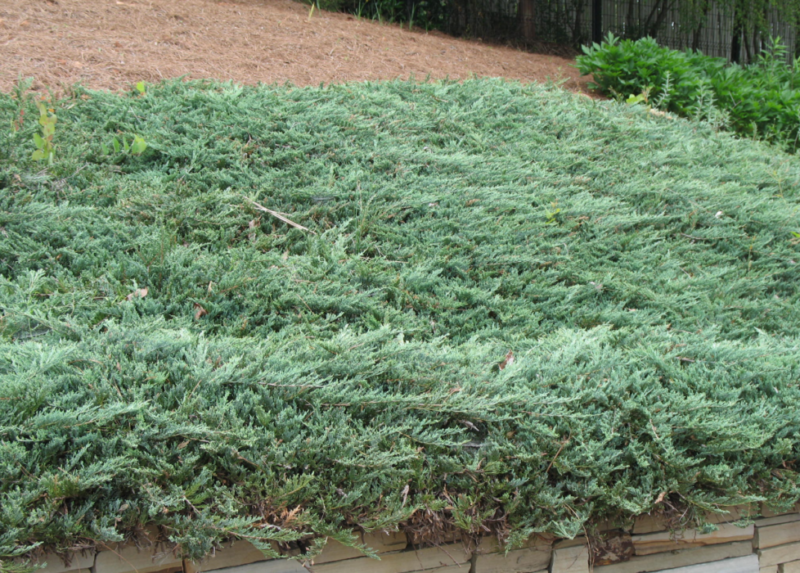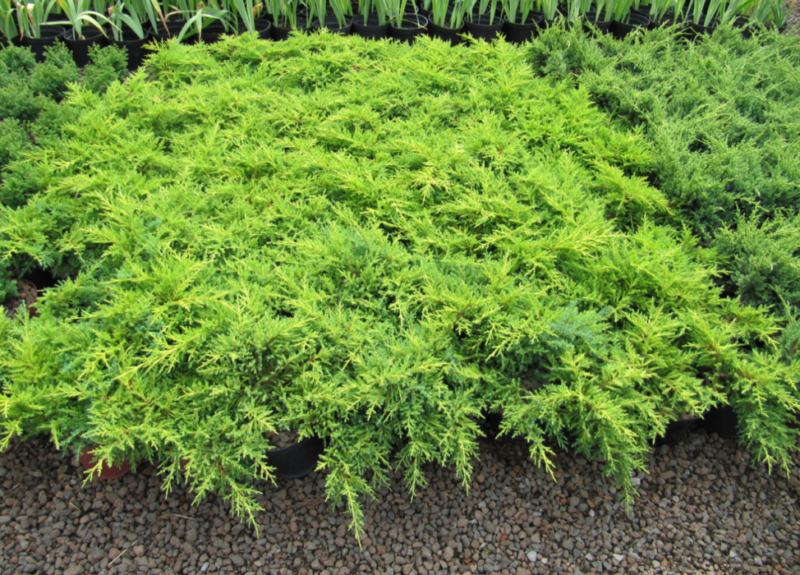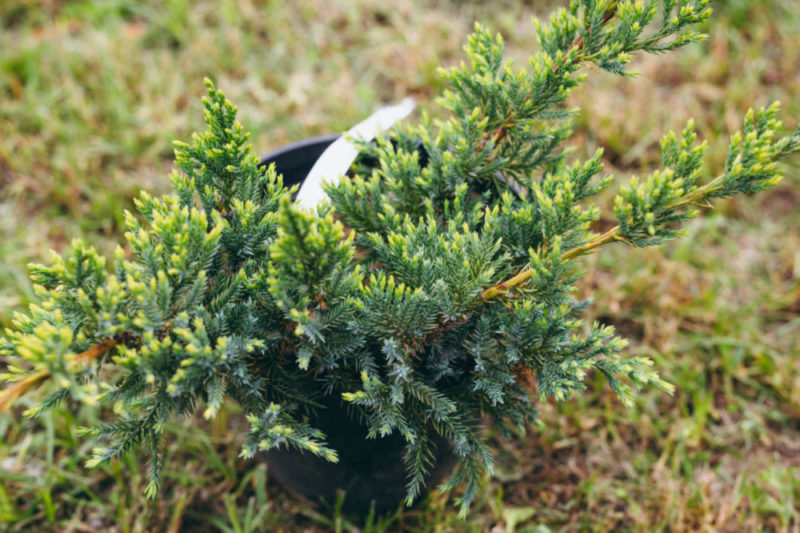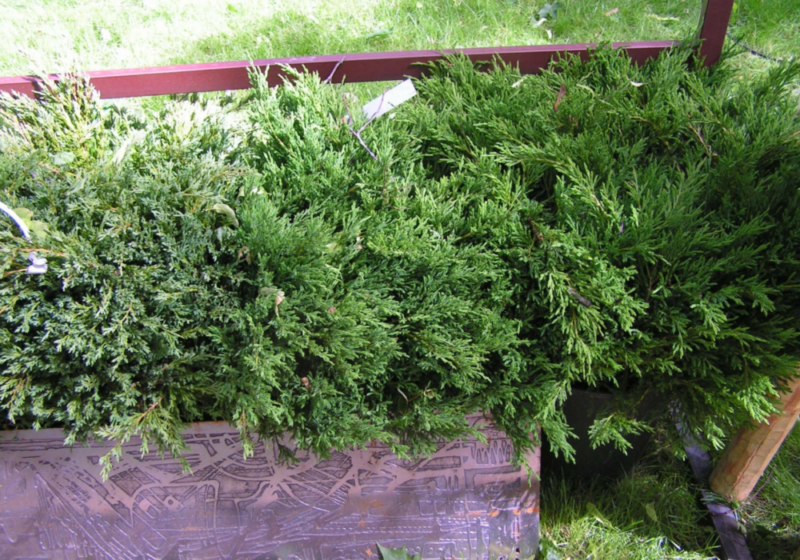The genus of junipers is so diverse that from its representatives you can create whole compositions without resorting to other conifers. There are spherical, pyramidal and horizontal. The juniper “Prince of Wales” with a maximum height of 25 cm belongs to the latter.
Material Content:
Description of juniper variety horizontal “Prince of Wales”
The variety is represented by multi-stem shrubs, which are characterized by branching from the root itself. As a result, each individual branch resembles a small tree. Spread over a large area, the juniper stands out with bright green needles, pleasing to the eye even in gloomy autumn weather, and pine cones that form on the site of female cones. A feature is the large diameter of the crown, compared with a height of 2.5 m at 25 cm, respectively. The growth rate is very slow: growth - 6 cm in width and 1 cm in height.
Note! Juniper Prince of Wales is frost-resistant and easily tolerates the effects of the north wind.
Outdoor landing
For representatives of the variety, not only sunny areas are suitable, but also slightly shaded areas. It should be remembered that the height of the plant depends on the access of light. In the first case, the crown will stretch up to 15 cm, and in the second - up to 25.
The coniferous tree is undemanding to soils, however, it prefers moistened loams with good throughput of water and air. The optimal pH reaction is 5.0-6.0.
Key recommendations for direct planting:
- Wells are made with a depth of 70 cm and a width of twice the root system of the seedling.
- For 1 square. m arrange no more than two landing pits.
- Drain from construction waste (broken brick, gravel, etc.) is necessarily placed at the bottom, while the layer thickness is about 15–20 cm.
- Fill the pit with a nutrient substrate mixed from peat, sand and turf in a ratio of 2: 1: 1.
- After planting, the trunk circle is necessarily moistened and mulched either with peat or with sawdust, depending on what is available.
On a note! Watering should be plentiful and carried out for a week after the work.
Chinese Juniper Care
So that the ornamental plant does not hurt and decorates the site with bright green for a long time, good care should be provided. Moreover, it is very simple.
Juniper needs watering and sprinkling in periods of soil and air drought. He generally tolerates the latter quite poorly, so spraying the plant is vital. The rest of the time, you should be careful not to overmoisten the soil. Excess vagi can cause the development of a fungal disease, which is very difficult to get rid of.
Several times during the growing season it is worth loosening the soil. To facilitate the task, until the plant reaches a large size, it is recommended to “put” burlap on it, collecting shoots together. In this case, you can easily carry out loosening and not be afraid to damage the roots. To prevent excessive evaporation of moisture and reduce the time for loosening, you can resort to a procedure such as mulching. Peat or sawdust will perfectly cope with this role.
You can not overfeed the plant, since an excess of fertilizer can even cause the death of the conifer. One feeding a year is enough. The optimal period is the second half of spring. It is better to use complex mineral fertilizers in the form of an aqueous solution. If granular agrochemicals are used, then before using them, the trunk circle should be shed abundantly with water. Otherwise, the rhizome can get a severe burn.
Sometimes gardeners are faced with a problem in which the needles become white. This is due to the lack of cropping. Despite the slow growth, every spring at the Prince of Wales variety it is necessary to remove rotted, damaged and growing shoots inside.
Preparing a cypress family plant for winter
In the characteristics of the species, as one of the pluses, high frost resistance is indicated. However, this does not apply to young cultures that have not yet developed a sufficient root system. They need to be covered with fir spruce or burlap. After two years, the main event in preparation for winter will remain mulching the trunk circle with a thick layer of peat.
Bush propagation
There are two simplest methods of vegetative propagation, which apply to horizontal juniper.
- Using layering. In spring, the strongest shoot is selected, which is stapled to the bottom of the previously dug groove. The shoot is sprinkled with soil. For the layering, the same care is carried out as for the mother liquor. Already with the coming of next spring, the rooted part can be separated from the maternal specimen and planted at a permanent place of growth.
- Cuttings. For similar breeding, cuttings obtained during spring pruning are used. They are buried in the ground and are necessarily covered with bottles, which will accelerate the rooting process due to the creation of greenhouse conditions. In this case, one should not forget to ventilate the plantings and systematically moisturize.
Juniper propagation is also possible by seed and grafting. But in the first case varietal characteristics will not be preserved, and the second method is very laborious and is used by professionals to obtain planting material on an industrial scale.
Protection against diseases and pests
The evergreen shrub has good immunity, therefore, in the description of the variety, you can see, as an advantage, its tolerance to pests. This is due to the release of a natural insecticide. But despite this attractiveness, the following harmful objects - aphids, scale insects, mealybugs, spider mites and shoot moths - can still be found on the shoots. The most effective way of protection is the use of approved pesticides. Their list is very extensive. They will help you choose the most suitable one at specialized points of sale.
Systematic waterlogging, lack of sanitary pruning, planting of poor-quality (sick) seedlings can become the causes of the development of an intractable fungal disease - rust. In case of its appearance, the shrub should be immediately treated with a copper-containing fungicide. In the future, a means of plant prevention will be spraying with similar means, arranged every spring.
Use in landscape design
Juniper horizontal varieties "Prince of Wales" has long been one of the favorites among landscape designers in creating coniferous compositions. The decisive role was played by its multi-stamping and ground cover.
Ideas for use:
- creating with it a living carpet on a green lawn;
- decoration of alpine hills and rockeries;
- composition formation with other conifers of various shapes and sizes as the lower tier;
- decoration of the terrace, loggia when grown as a container culture.
Juniper "Prince of Wales" - one of the brightest varieties with creeping shoots, covered with scaly needles with bright colors. It takes very little effort, and it will become an integral landscape composition of the site.


